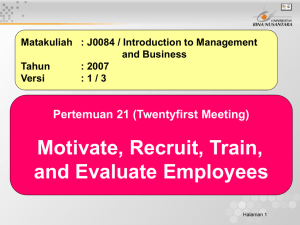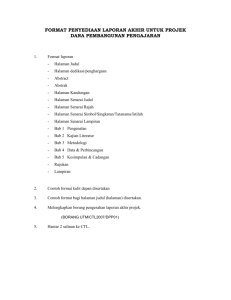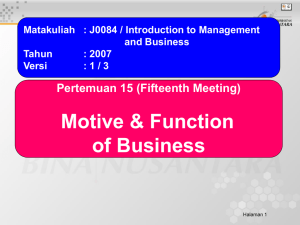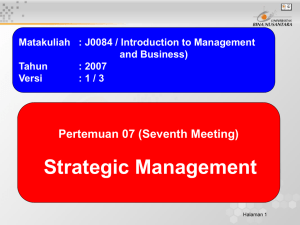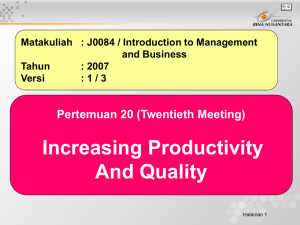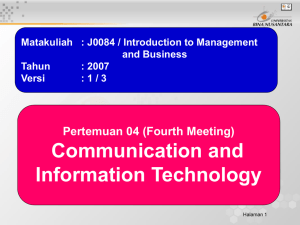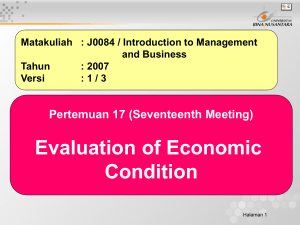Matakuliah : J0084 / Introduction to Management and Business Tahun : 2007
advertisement
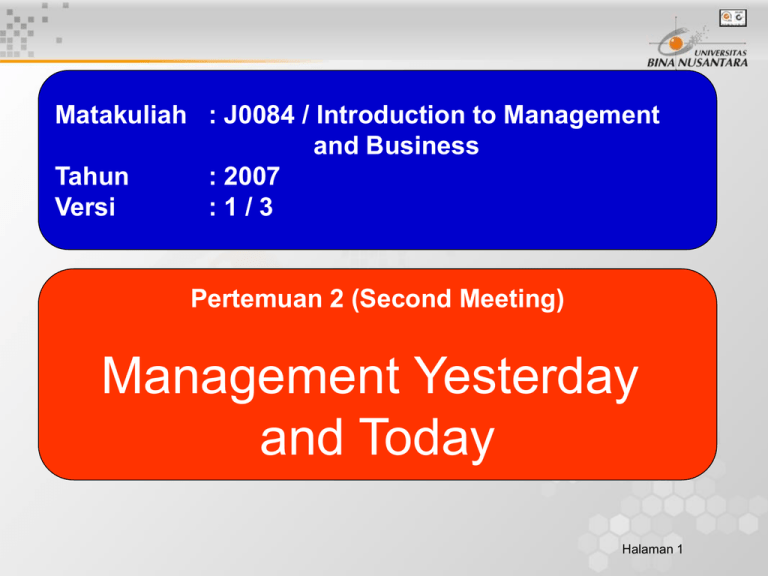
Matakuliah : J0084 / Introduction to Management and Business Tahun : 2007 Versi :1/3 Pertemuan 2 (Second Meeting) Management Yesterday and Today Halaman 1 Learning Outcome Student should be able to explain the development Of management, and also understand current trends and management issues -> C3 Halaman 2 Learning Outline • Historical Background of Management • Scientific Management • General Administrative Theory • Quantitative Approach • Toward Understanding Organizational Behavior • The System Approach • The Contingency Approach • Currents Trends and Issues Halaman 3 1. Historical Background of Management Management Theories Historical Back Ground Scientific Management Early Example Of Management Adam Smith Industrial Revolution Quantitative Approach System Approach General Organizational Contingency Administrative Behavior Approach Theory Early Advocates Hawthorne Studies Halaman 4 2. Scientific Management a. Frederick W.Taylor a) Develop a science for each element of an individual’s work, which will replace the old rule of thumb method b) Scientifically select and then train, teach, and develop the worker c) Heartily cooperate with the workers so as to ensure that all work is done in accordance with the principles of the science that has been developed d) Divide work and responsibility almost equally between management and workers. Halaman 5 b. Frank Gilbreth c. Lilian Gilbreth Studied work to eliminate inefficient hand-and -body motions. Invented a device called a microchronometer. Halaman 6 2. General Administrative Theory a. Henry Fayol Fayol’s Principle of Management: a) b) c) d) e) f) g) Division of work Authority Discipline Unity of command Unity of direction Subordination of individual interests to the general interest Remuneration h) i) j) k) l) Centralization Scalar chain Order Equity Stability of tenure of personnel m) Initiative n) Esprit de corps Halaman 7 b. Max Weber Weber’s Ideal Bureaucracy: a) Division of labor b) Authority hierarchy c) Formal Selection d) Formal rules and regulation e) Impersonality f) Career orientation Halaman 8 3. Quantitative Approach to Management a) Robert Mc.Namara b) Charles “Tex” Thornton Involves the use of quantitative techniques to improve decision making. This approach has been called: Operation research or Management science 1)Using statistical method & quantitative models 2)Linear programming - to improve resource allocation decisions 3) Economic Order Quantity (EOQ) Halaman 9 4. Toward Understanding Organizational Behavior a. Early Advocates: 1) 2) 3) 4) Robert Owen Hugo Munsterberg Mary Parker Follert Chester Barnard b. The Hawthorne Studies Halaman 10 5. The Systems Approach Environment System Transformation Input Process Raw Materials Employees’ work Human activities resources Management Capital activities Technology Technology and Information operation methods Feedback Environment Output Products and services Financial results Information Human results Halaman 11 6. The Contingency Approach 1) 2) 3) 4) Organization Size Routineness of Task Technology Environmental Uncertainty Individual Differences Halaman 12 7. Current Trends and Issues 1) 2) 3) 4) 5) 6) Globalization Ethics Workforce Diversity Entrepreneurship Managing In an E-Business World Knowledge Management and Learning Organization 7) Quality Management Halaman 13
